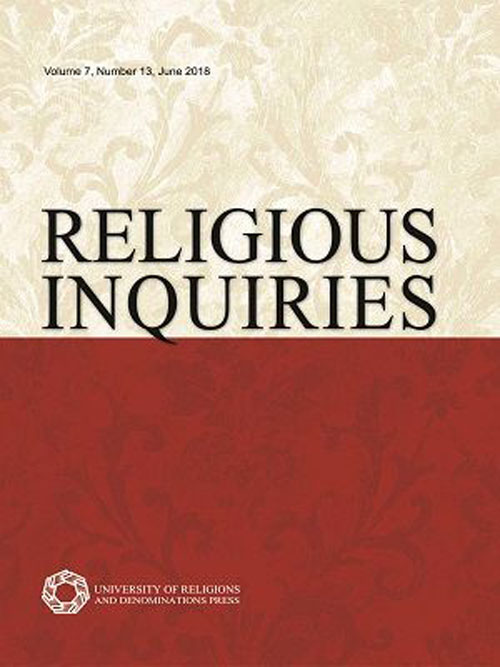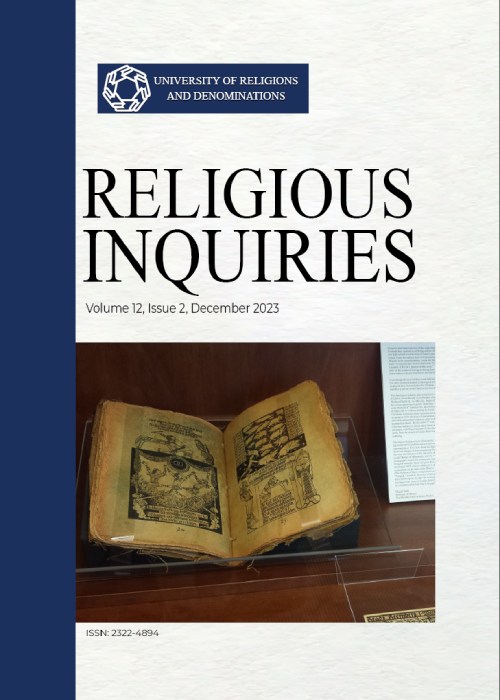فهرست مطالب

Religious Inquiries
Volume:7 Issue: 1, Winter and Spring 2018
- تاریخ انتشار: 1397/04/12
- تعداد عناوین: 7
-
-
Pages 5-15This article addresses the concept of authenticity, a characteristic of late modern Western culture. This characteristic is viewed by some as an ideal and by others as a root of the problems inherent within Western culture. After discussing various viewpoints, the author supports the idea that authenticity should not be totally accepted or rejected and sets forth a proposal based on the so-called negative ethics or skeptical ethics.Keywords: Authenticity, Western culture, sincerity, negative ethics, sceptical ethics
-
Pages 17-33Honesty in Islamic mystical ethics, at a superficial level, refers to the correspondence between speech, action, and intention and purpose. This application of honesty has been analyzed in depth in mystical ethics, and the analysis has resulted in honesty being considered as the foundation and basis of other virtues from five aspects, from which it can be understood that many of virtues are not virtues without honesty. In fact, these five aspects provide important and various meanings of foundational virtue in mythical texts. Considering this, one can find different levels and types of the virtue of honesty in mysticism and assess the obstacles in its path. A deep analysis of dishonesty and distinguishing self-deception are among the most important results of this specific approach to honesty. It is also in view of these analyses that mystics can explain how honesty can result in important ethical fruits, such as love for others, altruism, and abstaining from utilitarianism and egoism in actions, and how it leads to important psychological states, like happiness, satisfaction, hope, and strong inclination to virtues.Keywords: honesty, foundational virtue, ethical mysticism, self-deception, Phenomenology
-
Pages 35-54This paper will give an in-depth discussion of Jesus expression I am Alpha and Omega (Apocalypse of John = Revelation 1.8) and its influence on the Manichaean writings, on the one hand, and the reason for the division of Manis Living Gospel into twenty-two chapters, corresponding to the twenty-two letters of the Manichaean alphabet, on the other. The paper has explored all the related Jewish, Christian, and Manichaean texts available and strived to find out more about the reason for, and the origin of, this particular division. The deep connection between the word (or letters) and creation in Manichaean as well as in Jewish and Christian traditions seems to play an important role in this regard. The paper will answer many different, previously unanswered, questions and eventually propose a plausible resolution.Keywords: cosmic potency of letters, Mani's Gospel, Jewish literature, Christian literature, Manichaean literature
-
Pages 55-73This paper sheds light on the views of Mulla Sadra about virtue and action. The main question is how he explains the relationship, if any, between virtue and action. Mulla Sadra defines moral virtue as a settled inner disposition by which one acts morally, without need for any reflection or deliberation. This study seeks to explain how, according to Mulla Sadra, a virtue motivates the agent and leads him to do the right action easily. Is virtue the reason for or cause of action? Is there a semantic link between action and virtue? Can we regard an action as right if it is not motivated by a virtue? Another question is about the role of action in the development of moral character. Is virtue acquired through the practice of corresponding actions? If we divide virtues into moral and intellectual, we should ask about the relationship between an epistemic action and intellectual virtues as well. In addition, since Mulla Sadra is a Muslim religious thinker, explaining the role of faith and religious rituals in forming moral character and also the relationship between faith and moral action is important. This paper will show that Mulla Sadra accepts the semantic, metaphysical, and psychological relationships between virtue and action.Keywords: Mulla Sadra, moral virtue, action, intellectual virtue, semantic relationship, metaphysical relationship, psychological relationship
-
Pages 75-90If we categorize religions according to whether they give greater prominence to time or to space, the role of promise marks a religion of covenant as clearly a religion of time. Yet the future is unknowable and can only be present to us as a field of possibilities. How far do these possibilities extend? The question directs us back to the nature of time, a question that became concealed in the course of Western philosophical development or that was answered in terms of time's nullity. Modern philosophy (Levinas) has, however, pointed to the inseparability of time, language, and responsibility, thereby giving to time a positive content in terms of the ethical responsibility that, before God, we have for one another.Keywords: time, covenant, promise, eschatology, possibility, immortality, the other, language, responsibility
-
Pages 91-111For Muslims, the tawatur of the Quranthe fact that it has been massively and consecutively transmitted from generation to generation since the time of the Prophetis among the most important proofs which shows that the Quran we have today is the same scripture that was revealed to the Prophet. However, this proof has been neglected in the studies of Western scholars on the topic of the history of the Quran. Moreover, some Western scholars, such as John Wansbrough and Gerald Hawting, claim that since the Quran does not give any information about its formation and because there are no sources with information about the Quran that date back to the first two centuries of Islam, the Quran should be considered the product of the discussions and debates between Muslims and followers of other religions, with its text finalized in the early third century AH. However, contrary to Wansbrough and other like-minded scholars, who hold that the first two centuries of Islamic history are obscure and vague, a quick look at the history of Islam shows that in the first decades of Islam, Muslims had gone to different parts of the World, including some parts of Europe, and the Christians and Jews were watching the developments of this new religion. Hence, it is not possible that an important event, such as the formation of the Quran, could occur in the second or third century AH without any of the non-Muslim historians noticing it. In addition, many Western academics who have studied Islam and the Quran in recent centuries have trusted Muslim accounts on the matter.Keywords: Tawatur of the Quran, Orientalists, Quranic studies, history of the Quran, John Wansbrough
-
Pages 113-129In recent years, some people, comparing the word Ahmad in a Quranic verse speaking of Jesus prophecy about Prophet Muhammad (Quran 61:6) with the word Paraclete in the Gospel of John (14:26, etc.), have tried to make a connection between them. They have ascribed to Muslims (and even to the Prophet himself) the idea that the word Paraclete is a distorted form of the word periclete, the meaning of which, in turn, is approximately equal to the Arabic word Ahmad, to which the Quranic verse refers. In this article, we examine this idea and conclude that the claim has stemmed from a mistake in the writings of some western scholars during the eighteenth century, and does not have any actual basis in Christian or Islamic literature.Keywords: Ahmad, Muhammad, Paraclete, gospel, the Quran


